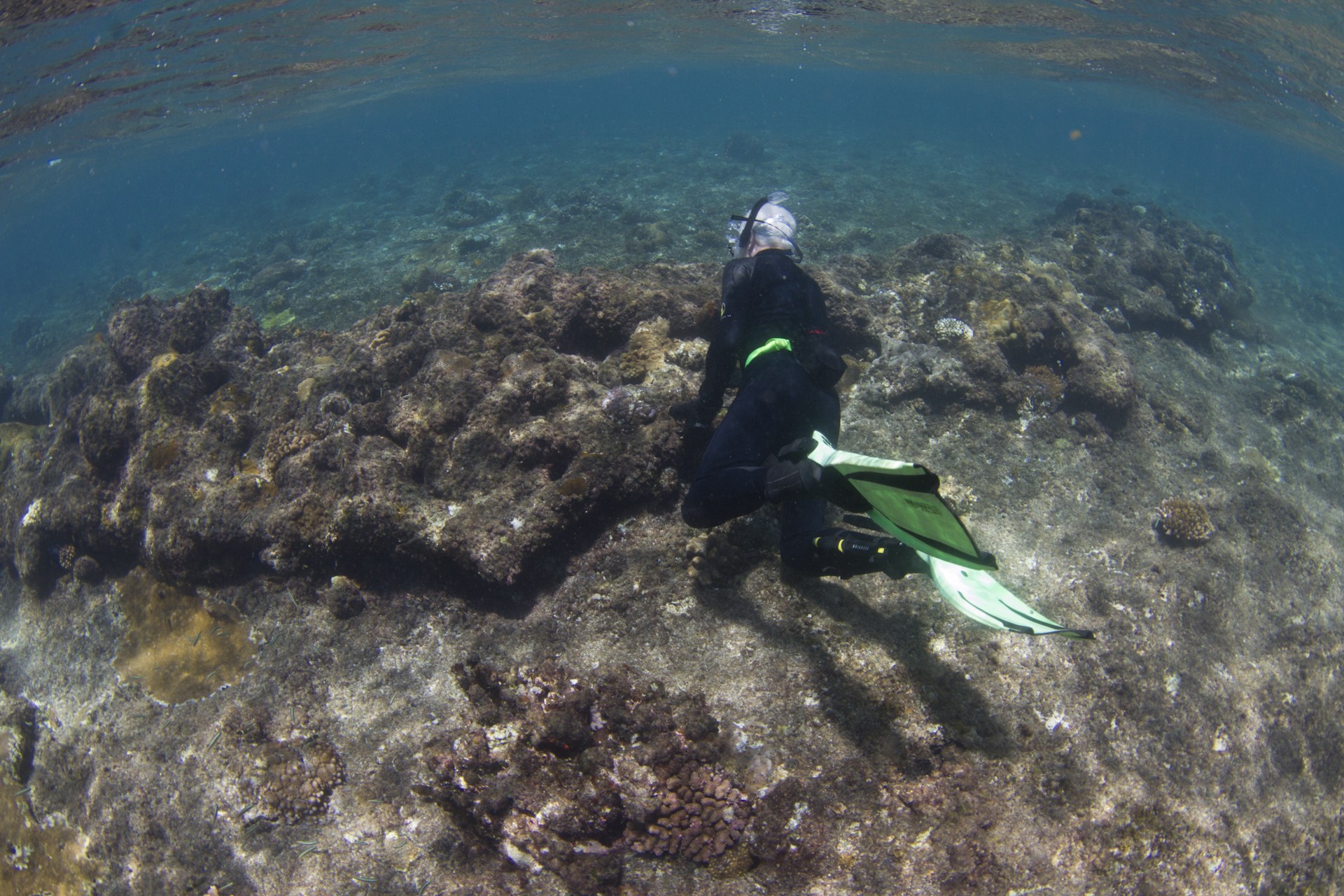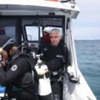
In April the Silentworld Foundation and the Australian National Maritime Museum returned from Ferguson Reef with a whole heap of information from the wreck-site of the Indian-built troopship Fergusson lost on Ferguson Reef in 1841 whilst on a passage to India from Sydney.
The team also brought back stacks of remote sensing data associated with our search for two other elusive shipwrecks associated with that early trade. The Indian built opium trader Morning Star lost south of Forbes Island in 1814 and the Javanese built trading ship Frederick wrecked of Stanley Island in 1818.

Kieran Hosty inspecting anchor chain during the Ferguson Reef expedition in March 2013
The Morning Star was a two masted, teak hulled, possible copper sheathed and fastened brig of 135 tons built by J. Scott and Company of Fort Gloster, India in 1813 for Lackersteen and Co and registered in Calcutta, India. (Parsons, 2003) Additional information, supplied from the Report of ships and vessels cleared outwards from Port Jackson in His Majesty’s Colony of New Wales 1/07/1814 – 30/09/1814 indicates the small vessel carried at least 8 cannon and a relatively large crew of 36 – hall marks of either a privateer or a vessel involved in the shipment of a valuable cargo – such as tea or opium.
On the 10 June 1814 the brig Morning Star arrived in Sydney with a ‘most valuable cargo of the newest teas from Canton that has imported in this Colony for many years’. The newspaper account goes onto state that the vessel had left Surabaya on the 19th April 1814 that the cargo had been consigned to Mr. Riley of 88 George Street, Sydney and the vessel would it leave port immediately on discharge of its cargo. (The Sydney Gazette and New South Wales Advertiser, 11 June 1814)
In all 1357 packets of goods – including tea, candles, soap, sugar, silk, cotton, ceramics, jewellery, ivory and 350 gallons of wine – with a total declared value of 8793 pounds 5 shillings were landed in Sydney with the owners paying duty of just over 450 pounds on the goods. The largest amount of duty paid that year for any vessel. (Historical Records of Australia, Vol. VIII, pp336)
On July 2 1814 the Morning Star departed Sydney for Batavia and Calcutta in ballast under the command of Captain Robert Smart, a crew of 35 and possible two paying passengers – Emma Greenwood and Catherine White who announced in the Sydney Gazette and New South Wales Advertiser (25 June 1814) that they were departing the colony in the Morning Star.
On 30th September 1814 the crew of the Eliza, on a voyage from Sydney to Calcutta, observed a flag flying from a makeshift flagpole on Booby Island at the entrance to Torres Straits and rescued five shipwreck survivors. (Sydney Gazette, 19 April 1815)
The survivors reported that were off the brig Morning Star which had been wrecked on a coral reef south of Forbes (Wuthara) Island offshore from present day Lockhart River – some 350 kilometres north of Cairns.
The Frederick is reported to have been 210 ton, two masted brig, registered in Calcutta and Javanese built. The Report of ships and vessels cleared outwards from Port Jackson in His Majesty’s Colony of New Wales 1/07/1814 – 30/09/1814 goes onto state that the Frederick was armed with 4 guns, had a crew of 42 and was owned by Palmer and Co of Calcutta. (HRA, 1916)
The East-India Register and Directory for 1819 states that Palmer and Co –were general merchant and agents of Calcutta whose principle John Palmer (1767-1836) was also a Director of the Bengal Provident Society, a committee member of the Second Calcutta Tontine, Director of the Asiatic Life Annuity Company, the Fourth Calcutta Laudable Society and the Asiatic Society. John Palmer was also related, by marriage, to Robert Campbell of the Calcutta and later Sydney based merchants Campbell and Clark – owners of the Sydney Cove which was wrecked on Preservation Island, Tasmania in 1797.
In March 1818 the Frederick under the command of John Thomas Williams appears at Hobart from an unspecified port, loads 61 head of cattle and departs in company with the ship Duke of Wellington for Mauritius. After several attempts at sailing west against the prevailing wind – in late June the two ships head north via the Inner Route again bound for Port Louis, Mauritius.
In September 1818 the two vessels had anchored overnight off Cape Flinders, Stanley Island in the Flinders Group when the Frederick whilst getting underway the next morning went broadside onto a reef, became fast and cantered over onto its side. The crew fired the vessel’s guns as distress signals which were heard by the Duke of Wellington which had already departed from the anchorage. The Duke of Wellington dispatched two of its boats to render assistance and the Frederick was abandoned with 21 passengers and crew taking to the longboat – along with 5 casks of powder, 39 pounds of salt beef and half a bushel of pease. Captain Williams of the Frederick with five others took to the smaller jolly boat and both boats then made for the Duke of Wellington. (Sydney Gazette, 15 may 1819)

Maggie with Frits Breuseker and John Mullen on board, Forbes Island in the distance.
Photo: Xanthe Rivett, Silentworld Foundation
Unfortunately the heavily laden long boat could not make its way against the strong current and failed to rendezvous with the Duke of Wellington. When the jolly boat finally caught up with the Duke of Wellington a search was organised and the Duke of Wellington returned to Stanley Island to salvage additional supplies and several anchors from the Frederick – but the long boat with 21 people on board could not be located and was given up for lost. (Sydney Gazette, 15 may 1819).
Like the Morning Star the wreck of the Frederick was noted by the respected Australian navigator and explorer Phillip Park King on one of his voyages around Australia and also like the Morning Star, despite several attempts, the site has never been discovered.
Fast forward almost 200 years and in April 2013 the Silentworld Foundation and the Museum carried out an extensive remote sensing survey of Forbes and Stanley Islands Island searching for the wreck-sites of the Morning Star and the Frederick.

Andrew Turner carrying out a detector survey at Fison Reefs. Photo: Xanthe Rivett, SWF
Luckily for us – Frits Breuseker from surveying company SeeSea Pty Ltd.) – was subsequently contracted by the Silentworld Foundation to analyse the remote-sensing data accumulated during the Ferguson Reef Project 2013 and thanks to Frits work – and the generous assistance of the Silentworld Foundation and the Great Barrier Reef Marine Park Authority – the Museum is going back into the field next week – this time armed with additional survey information which may allow us to locate these two significant missing shipwrecks.
Kieran Hosty
Manager – Maritime Archaeology
